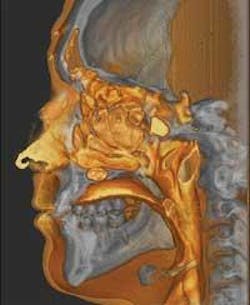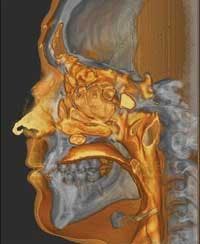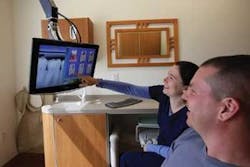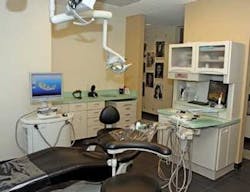The time for enhanced technology is now!
By Scott D. Benjamin, DDS
For more on this topic, go to www.dentaleconomics.com and search using the following key words: dental caries, enhanced technology, technology plan, Dr. Scott Benjamin.
To quote Albert Einstein, “Insanity: doing the same thing over and over again and expecting different results.” This quote should be the battle cry of dental professionals as to why we need to incorporate advanced technologies in mainstream dental practices today. Dental caries is still the most common infectious disease in humans, and studies show that periodontal disease is present in approximately 90% of adults worldwide. These facts demonstrate that, as oral health professionals, we need all the assistance we can get so we can change the way we assess, educate, treat, and manage our patients' oral health care.
In the uncertainty of today's economic environment, many clinicians are questioning whether this is the time to enhance their practices by updating or buying new technology. The facts suggest the need, so the simple answer is “yes.” With the economy of today, where better to invest than in yourself? Properly investing in your practice not only gives you control of finances but also positions your practice for continued growth professionally and financially. The real question should not be if to invest in new technology, but in which technology to invest.
Webster defines technology as the science or study of the practical or industrial arts, and also as applied science. Notice the key word is science. In dentistry, unfortunately, dental technology is most often thought of as the use of the latest gadgetry when performing oral health care. To many practitioners, the role of science is often ignored, if not forgotten. When evaluating new technologies, a key element that should always be remembered is that the laws of physics and science do not change, despite what dentists might hear from a salesperson or colleague.
The proper integration of technologies into a dental practice requires careful thought and analysis of the positive and negative aspects. I practice in a rural community with patients of modest means. Thus, when it comes to spending dollars in dentistry, I have to be more concerned than normal.
Yet I have a successful high-tech, filmless, chartless practice that has almost every type of technology ever created. As these technologies were selected and developed, my primary focus was always the roles and functions they would provide to patients and the practice.
It is essential to remember that technology in a dental office must serve at least one of two functions. First, does this technology improve the quality of care that we can deliver to patients? If it does not help us improve the quality of care, do we need it?
For the most part, the answer is “no” unless it answers the second function of delivering quality care in a more efficient manner. Our time, as well as a patient's time, is extremely valuable. So efficiency should be an important concern as we move forward. If it does not answer either of these questions positively, then is it of real value? Is it a necessity? Do we need it to practice effectively or are we buying a new toy that brings little or no value to us or patients?
The most important characteristic of successfully moving forward is having a comprehensive technology plan for the practice. As Forrest Gump said, “If you don't know where you are goin', you will probably not wind up there.”
Because of the lack of proper planning, many dentists start buying pieces instead of solutions. They buy pieces without knowing what puzzle they are trying to solve and then wonder why the pieces do not fit together. The pieces then end up in the junk pile, often not as a fault of the technology, but due to lack of understanding of the modality and not having a comprehensive technology plan.
These dentists acquired the technology for the sake of having the technology rather than any real benefit. They purchase product X, not because of its value to patients or because it will improve the practice's overall efficiency, but because a colleague has it or they want to use it as a way to market their practice.
Dentists should never use technology as a “white knight” to lead the charge or save their practices. For success, the clinician needs to learn and thoroughly understand the knowledge that is required for optimum integration and successful outcomes. When you seriously look at the complexity of where we have taken our profession in the last 20 or 30 years, it is mind boggling.
These technologies are not designed to turn off our brains and think for us. They are designed to help turn our brains on and give us more information to evaluate, and to assist in obtaining the precision for which our profession strives. To quote a friend, “They are a thinking man's tools!”
When selecting new technology, considerations need to be made for what existing systems in the practice will be enhanced or replaced. This includes the physical requirements and changes the new technology will necessitate in workflow, scheduling, and patient fees. How it will be introduced, accepted by, and benefit patients also need to be addressed.
When considering a new technology, some thoughts in the evaluation process should be the:
- Practice's strengths, weaknesses, and focus
- Physical layout and design of the office
- New or enhanced procedures it enables for the practice
- Staff's present knowledge in the area<
- Training time needed
- Learning curve for the staff
- Ergonomics and workflow
- Infection control requirements and procedures
- Scheduling and patient flow
- Related changes in fee structure
- Effects on the overall fees collected
- Real return on investment (ROI)
- Real total expense considering all of the above
- Real value and practice's true need
The entire team must understand the value for optimum utilization and proper workflow, and the benefits it brings to the practice. The Achilles heel of successfully integrating new technology is staff training.
A common cause for this shortfall is lack of time for thorough initial training and needed follow-up training. This has a major impact on the frustration level during the early stages of the learning curve when implementing a new technology.
Additional frustration is experienced from the necessary changes that will have to be made to the routine workflow that has been developed. Many new technologies, especially those related to enhanced diagnostics, require that we also educate patients to the benefits of these procedures, and how they change past dental treatments.
Diagnosis is the foundation of everything we do; however, we are perceived as procedure-based, piecemeal, factory workers in dentistry. The concept is that, until we pick up a handpiece, we have done nothing for patients. We have done a good job of brainwashing ourselves and patients into thinking this. When a patient goes to a physician, they spend an average of six minutes together. What do they do?
They evaluate the patient, carry out a health assessment, then “just” give advice or possibly write a prescription. Yet in dentistry, we practically give this away for little or no compensation. This gives patients the perception that a comprehensive oral examination has minimal value to their overall health orally, systemically, or even financially.
This reinforces patients' beliefs that we need to use handpieces in order for them to think something has been done for them. This perception has to change, first in ourselves, and then in patients, and possibly even third party insurance carriers.
In the near future, many of the restorative procedures for which general dentists are being compensated will be performed by a midlevel dental clinician. This is happening in some of the provinces in Canada and other places. This is designed to reduce the access-to-care issue that has become a political buzz phrase.
The primary role of the dentist will be that of a diagnostician. Now is the time to start focusing on technologies that will improve diagnostic abilities. This will assist in making appropriate clinical evaluations and decisions to have better outcomes for patients. I believe we need to change dentistry from a surgical to a healing profession.
The goal of diagnostic technologies is to confirm health, identify potential risks, and detect variations from normal health as soon as they occur — in a safe and noninvasive way.
This pertains to evaluating a patient's overall systemic health and the hard and soft tissues of the oral cavity. Many of these diagnostic modalities use light-based technologies of specific wavelengths, intensity, filtration, and receptors to give clinicians specific information that can be incorporated into their patient assessments.
These diagnostic modalities enable clinicians to discover and manage diseases, including interproximal caries not visible on the bitewing to be detected on the same radiograph by evaluating with radiograph density (Logicon Caries Detection System).
In addition, there are systems that detect caries by stimulating a fluorescence response from the bacterial byproduct porphyrin. The VELscope fluorescence visualization mucosal screening system enables the detection of many mucosal abnormalities at the earliest stages, even as small as a few millimeters.
I have been involved in development of the VELscope for evaluating the soft tissues of the oral cavity. One of the things that bothered me was that the death rate from oral cancer had not changed in 30 years. I graduated from dental school 30 years ago! When combined, these two facts are a personal insult. I think the first is probably the most embarrassing statistic in medicine. But until the development of fluorescence visualization technology, did our mucosal assessment procedures change? No, so why should we have expected outcomes to change? Einstein's quote on insanity applies here. Oral cancer is the only cancer in which the death rate has not decreased, and the occurrence is increasing by 10% per year.
I'm thrilled to report that by using fluorescence visualization technology, I detected several dozen potentially malignant lesions in the dysplastic stage that were confirmed with a biopsy and then treated with simple laser ablation. This technology enables the management of these conditions by closely monitoring their status to provide patients and clinicians increased confidence in care.
Medications have a myriad of effects on the oral cavity. Monitoring these effects without the assistance of a drug interaction data base such as Lexi-Comp is not possible. Today, there are approximately 800 medications that have a xerostomic effect. Can anyone cite even 40 of them?
As baby boomers reach retirement, most are on multiple medications from several prescribers. Can any of us know the oral effects and potential conflicts with oral health and treatments? In one week, there were more than 400 changes in medication protocols and interactions.These include medications we use daily in dentistry, such as amoxicillin and ibuprofen.
The Electronic Health Record, with the National Healthcare Information Infrastructure, and conformance with Digital Image Communication in Medicine standard that integrates aspects of the patients' health information into a single patient record should be a reality in the next few years. This unified patient record should significantly reduce the amount of medical record errors and help improve patients' well-being and quality of life.
Several light-based technologies now are being researched and perfected. The frequency-doubled Alexandrite Laser has the ability to pick up calculus and leave cementum intact. This should change our hygiene efforts. With Optical Coherence Tomography, we can discover an area of concern in the tissue. By placing a couple of light probes on the tissue, we can perform an “optical biopsy” and look into the tissue to determine what is the best treatment.
With near infrared imaging, enamel becomes invisible at 1310 nanometers. Thus, we can start looking through teeth and view things that we have not seen previously. This is done with nonionizing radiation with no harmful side effects to the patient.
So what is technology doing for us?
It is taking the surgical profession of dentistry and making it into a diagnostic healing profession. It is getting rid of the obstacles to care.
Where are we going in the future?
When asked when Disneyland would be finished, Walt Disney, one of the greatest visionaries of our time, answered: “The word finished means the lack of imagination, and as long as there is imagination it will never be finished.”
The same can be said for dental technology since its true value is to improve the quality of life for all patients. It was also Walt Disney who said, “All our dreams can come true, if we have the courage to pursue them.”
Dr. Scott Benjamin is in private practice in Sidney, N.Y. He is a visiting professor at SUNY at Buffalo School of Dental Medicine, and is a member of the 2005 WHO Collaborating Centre for Oral Cancer and Precancer 2005 Working Group. Dr. Benjamin is on the editorial board of several peer-reviewed dental journals. Reach him via e-mail at [email protected].



